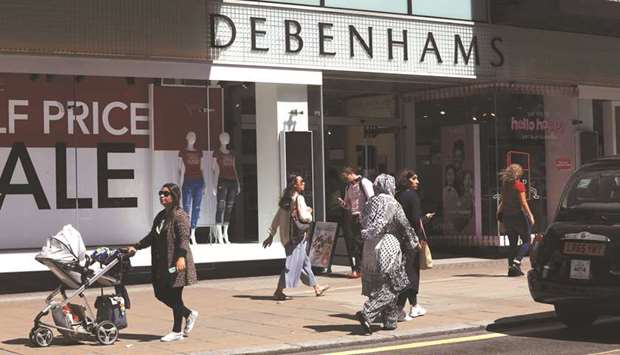British retailers racked up surprisingly strong sales last month, reinforcing how spending by consumers is a bright spot for the economy ahead of Brexit.
Retail sales grew by an annual 4% in February, the top end of a range of forecasts by economists in a Reuters poll, and down only slightly from January’s two-year high of 4.1%, official data showed yesterday.
Mild weather last month boosted spending at garden centres and on sporting equipment, offsetting a fall in spending at supermarkets and in clothing stores after sales promotions in January, the Office for National Statistics said.
Sterling pared some early losses on the news. “It is possible that some consumers brought forward purchases amid concern prices could rise if a disruptive Brexit at the end of March sees sterling weaken sharply,” Howard Archer of economic consultancy EY ITEM Club said.
Consumer spending has been a source of strength for the world’s fifth-largest economy at a time when businesses say that Brexit uncertainty is forcing them to postpone investment and a slower global economy is hurting export demand.
Prime Minister Theresa May urged lawmakers on Wednesday to back her Brexit plan, which they have rejected twice. If she fails again next week, Britain could leave the EU on March 29 without a transition deal to cushion the economic shock.
Yesterday’s data showed sales volumes in February alone rose 0.4% versus a forecast of a decline in the Reuters poll.
Annual sales growth for the three months to February was its strongest in over two years.
Falling inflation, a steady rise in wages and the lowest unemployment since 1975 have all boosted household incomes over the past year, though wages are still below their peak before the financial crisis after factoring in inflation.
Earlier yesterday, British clothing chain Next reported a small fall in annual profit, hurt by lower store sales, and it forecast another decline for this year, but said Brexit was not to blame.
Separate figures from the ONS showed the government was likely to meet its updated borrowing goals for the 2018/19 financial year, as Britain’s jobs boom boosted income tax revenue.
Public borrowing for February, the 11th month of the tax year, fell to £0.2bn ($0.3bn) from £1.2bn a year earlier, below economists’ average forecast of £0.6bn in a Reuters poll.
With just one month remaining of the current financial year, government borrowing totalled £23.1bn, down 44% from the same point in 2017/18 and the lowest since 2001/02, though these figures are likely to be revised further.
Last week Britain’s official budget forecasters cut their 2018/19 borrowing forecast to £22.8bn or 1.1% of GDP from £25.5bn.
Finance minister Philip Hammond said at the time that if Brexit went smoothly there would be more money available at a multi-year spending review due late this year. “Hammond has capacity to increase spending on under-pressure public services, while potentially also cutting taxes.... However he, like the rest of us, is waiting to see what happens with Brexit,” said Martin Wheatcroft, an advisor to the Institute of Chartered Accountants in England and Wales (ICAEW).

Pedestrians pass a Debenhams department store advertising a half price sale in London. Britain’s retail sales grew by an annual 4% in February, the top end of a range of forecasts by economists in a Reuters poll, and down only slightly from January’s two-year high of 4.1%, official data showed yesterday.

